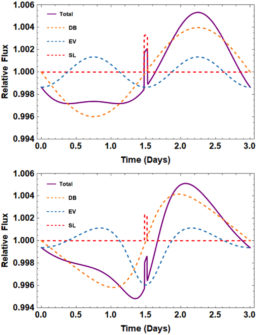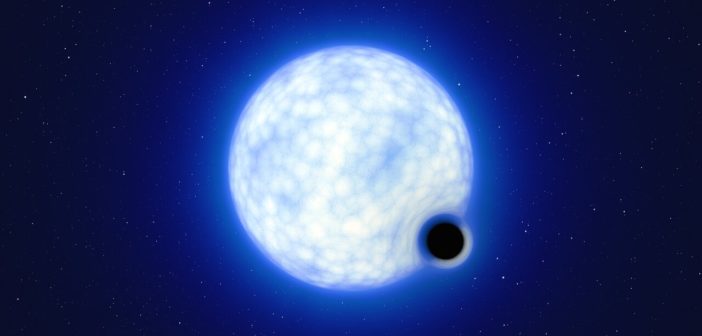
Circinus X-1, shown here in X-ray (blue) and radio (purple) emission overlaid on an optical image, is a binary system containing a main-sequence star and a neutron star, which was discovered because of its bright X-ray emission. [X-ray: NASA/CXC/Univ. of Wisconsin-Madison/S. Heinz et al; Optical: DSS; Radio: CSIRO/ATNF/ATCA]
Searching for Compact Objects
When stars expire, the remnants left behind — black holes, neutron stars, and white dwarfs — are difficult to detect. Black holes emit no light, and tiny neutron stars and white dwarfs shine only weakly compared to stars in their prime. These hard-to-detect compact objects sometimes reveal themselves by accreting gas from a binary companion; as gas spirals toward the object, it forms a superheated disk that blazes in X-rays.
But how do we find compact objects that don’t announce themselves through accretion? In a new publication, Nicholas Sorabella (Lowell Center for Space Science and Technology and University of Massachusetts Lowell) and collaborators show how models can help us identify quiet compact objects in binary systems.
Questing for Companions
Instead of trying to detect faint or invisible binary companions directly, Sorabella and collaborators explored how the presence of an unseen object affects the other component of the binary system: the star. The brightness of a star locked in a binary system with a compact object will change over the course of an orbit for three reasons:

Modeled light curves for a binary system containing a solar-mass star and a 10-solar-mass black hole with an orbital period of 3 days. The curves show the effects of Doppler boosting (DB), ellipsoidal variations (EV), and self-lensing (SL), as well as their combined effects. Top: orbital eccentricity of 0 (circular orbits); bottom: orbital eccentricity of 0.3. [Adapted from Sorabella et al. 2022]
- Self-lensing: When a compact object passes in front of a star, its gravity bends the star’s light, temporarily boosting the star’s brightness.
- Doppler boosting: As the companion star travels along its orbit, its starlight appears brighter to an observer on Earth when the star is moving toward Earth and fainter when the star is moving away from Earth.
- Ellipsoidal variations: A compact object exerts extreme tidal forces on its stellar companion, stretching the star into a teardrop shape. The asymmetrical star’s brightness changes as it’s seen from different angles during its orbit.
In this work, Sorabella and collaborators develop a model that predicts how self-lensing, Doppler boosting, and ellipsoidal variations affect the brightness of a star with an elongated, or eccentric, binary orbit. The authors’ model also incorporates effects from limb darkening — the decrease in brightness toward the outer edge of a star due to those layers being cooler. By modeling how these effects ebb and flow as a compact object and its stellar companion whirl around each other, the team is able to extract the masses of both binary members and other key aspects of the binary system — all without ever detecting the compact object directly.
Putting It to the Test

The observed optical light curve of Cygnus X-1 (blue) and the best-fitting model (orange). [Sorabella et al. 2022]
Upcoming surveys are likely to observe thousands of systems containing compact objects, and researchers estimate that roughly 200 of these systems will have discernible self-lensing signals. Only a handful of non-accreting neutron stars and black holes in binary systems have been detected, so models like those of Sorabella and collaborators will allow us to investigate a nearly unexplored population of stellar remnants.
Citation
“Modeling Long-Term Variability in Stellar–Compact Object Binary Systems for Mass Determinations,” Nicholas M. Sorabella et al 2022 ApJ 936 63. doi:10.3847/1538-4357/ac82b7

